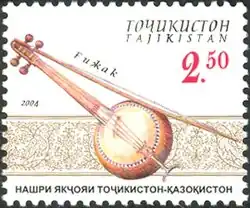Ghijak
The ghijak (also spelled ghidjak, ghichak, gidzhak, gijak, g'ijjak,[1] or ghijek (Uyghur: غىجەك, ғиҗәк, romanized: ghijek, or occasionally Uyghur: غىرجەك, ғирҗәк, romanized: ghirjek; Chinese: 艾捷克 aijieke or 吉孜哈克 jizihake; Russian: Гиджак), is a group of related spike fiddles, used by Afghans, Uzbeks, Uyghurs, Tajiks, Turkmens, Qaraqalpaks[2] and in the Xinjiang province of western China. Despite the similarity of the name, it is more closely related to the Persian kamancheh than the ghaychak.
 | |
| Classification | |
|---|---|
| Related instruments | |
History

The instrument name appears in 10th-century manuscripts, which indicate that the bridge (harrak) was made of almond shells. The ghidjak as depicted in 15th-century Persian miniatures resembles the modern instrument in its construction.[1]
Xinjiang
The ghijek as it is used in Xinjiang has four strings, either with a bowl soundbox (similar to the kamancheh), or with a box soundbox often made from a tin can.[3] One of Xinjiang's most prominent ghijek players is Akram Omar (艾克热木·吾买尔 / ئەكرەم ئۆمەر / Акрам Омар), from Kashgar.video
See also
References
- John Baily and Razia Sultanova (2001). "Ghidjak". Grove Music Online (8th ed.). Oxford University Press. ISBN 978-1-56159-263-0.
- "Ghijak". Aga Khan Development Network. Retrieved 2020-08-24.
- "Badakhshani Instruments". Retrieved 2020-08-24.
External links
- Afghan ghaychak (box lute)
- Tajik ghijak (box lute Archived 2009-04-15 at the Wayback Machine